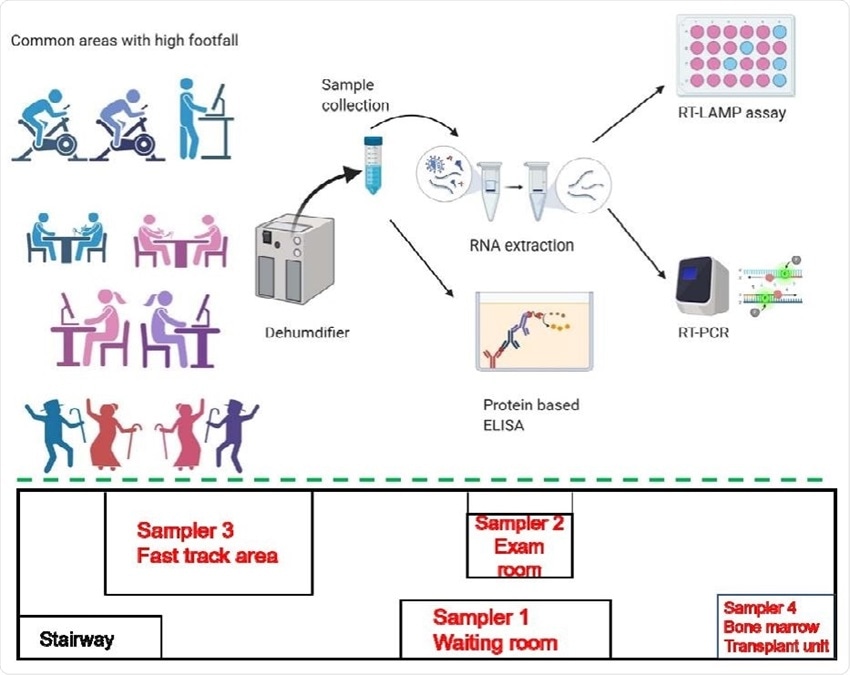Airborne SARS-CoV-2 Virus Detectable By Using Dehumidifiers According To University Of Maryland Study
Source:Airborne SARS-CoV-2 Oct 15, 2020 4 years, 5 months, 2 weeks, 6 days, 9 hours, 46 minutes ago
Airborne SARS-CoV-2 virus can be detected by using dehumidifiers according to a new study by researchers from Maryland University.

The study team presented a simple approach that can potentially provide information about the prevalence of SARS-CoV-2 virus in the atmosphere at any location.
The study findings are published on a preprint server and are currently being peer reviewed.
https://www.medrxiv.org/content/10.1101/2020.10.08.20208785v1
The SARS-CoV-2 coronavirus primarily spreads through respiratory droplets when infected individuals cough and sneezes. A recent update from health agencies confirms that the virus can spread through airborne particles.
Numerous studies now show that the SARS-CoV-2 can spread via aerosols that can hang in the air for long periods.
To date however, it has not been easy to assess the actual environmental threat since there are no procedures and tests present.
The study team from the University of Maryland along with experts from the University of Illinois and the STAR Laboratory at the Sri Sathya Sai Institute of Higher Learning-India, have presented a simple approach that can potentially provide information about the prevalence of SARS-CoV-2 in the atmosphere at any location.
As there are shared similarities between SARS-CoV-2 and other coronaviruses such as the MERS-Cov and SAR-CoV, both of which were also found to be airborne and could spread even in long distances, it is essential to study how SARS-CoV-2 could spread to reduce the risk of infection.
The study team aimed to see the extent and prevalence of SARS-CoV-2 infection in the air. To arrive at the study findings, the researchers used a portable dehumidifier as a convenient and affordable tool to collect airborne SARS-CoV-2 virus in the condensate.
The study team situated the dehumidifiers in selected areas of a hospital ward with patients who reported flu-like illness, which could be COVID-19. These dehumidifiers stayed there over three separate periods in one week. The team studied the samples frequently for both the virus envelope protein and SARS-CoV-2 RNA.
The study team found that in several samples across separate areas, the condensate from dehumidifiers tested positive for the presence of SARS-Cov-2.
Corresponding author, Dr Govind Rao from Center for Advanced Sensor Technology, University of Maryland said, “Our results point to a facile pool testing method to sample the air in any location in the world and assess the presence and concentration of the infectious agent to obtain quantitative risk assessment of exposure, designate zones as ‘hot spots’ and minimize the need for individual testing which may often be time-consuming, expensive and laborious.”
The researchers believe that the simple test highlights the need for an effective but easy-to-do technique to detect the virus in high-density environments. Being able to understand the day-to-day exposure risk to virus aerosols is crucial to implement fast and reliable interventions to contain the spread of the virus, as well as safeguard hum
an health.
The method could also be used when there is the unavailability of individual testing in many remote areas. This way, the presence of the virus particle in the air could spark infection control measures to stop the spread of the virus.
 Schematic representation of sample collection and analysis for mass detection and simplified layout of the hospital ward indicating the positions of various dehumidifiers.
Schematic representation of sample collection and analysis for mass detection and simplified layout of the hospital ward indicating the positions of various dehumidifiers.
To date, there are now almost 38.5 million people globally who have been infected with SARS-CoV-2 and over 1.1 million people who died from complications.
America remains the nation with the highest number of cases, topping 7.91 million, and having 216,724 deaths followed by India, with over 7.24 million infections and 110,614 deaths.
Nine months into the COVID-19pandemic, many researchers and scientists described that COVID-19 could spread via aerosols, given the fast spread of the virus across countries.
Numerous documented cases were traced back to enclosed areas with little ventilation, hinting that the virus may have spread through the air.
Finally both the World Health Organization (WHO) and the U.S. Centers for Disease Control and Prevention (CDC) are admitting that there are pieces of evidence that show the airborne transmission of SARS-CoV-2. The agencies recommend that individuals should wash their hands regularly, maintain social distancing, and always wear a mask, especially when going out. Further, both he agencies emphasized that staying indoors in areas where there is poor ventilation could elevate the risk of contracting the virus.
The study team concluded, “In the light of the recent pandemic, most countries are struggling to strike a balance between protecting their residents and keeping their economies from crashing further. In such unprecedented times, the world has witnessed overburdening of healthcare facilities and increased risk of transmission via healthcare workers and places with high human footfall. In an attempt to reduce the possibility of infection by adopting testing methods capable of producing effective and fast results in a cost effective manner, we have proposed herein a simple, facile and affordable testing method for areas with high population density or footfall by avoiding laborious and time consuming individual testing. The use of dehumidifiers in designated areas would allow for analysis of the collected condensate in a rapid and facile manner, thus allowing authorities to designate zones as ‘hot spots’ in case of a positive result. The method of sampling is both novel and effective, given the nature of transmission of coronaviruses and the unavailability of individual testing in many remote areas. With the much-dreaded possible approach of the second wave of the virus, this strategy would help in reducing the number of infected cases in a timely manner without exhausting public coffers and overwhelming the healthcare infrastructures especially in countries with scanty resources.”
For more on
Airborne SARS-CoV-2, keep on logging to Thailand Medical News.

